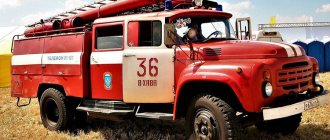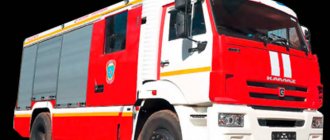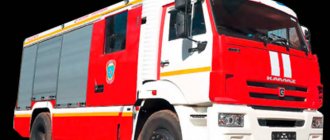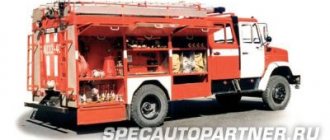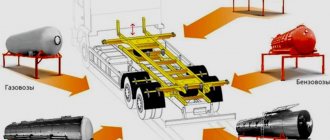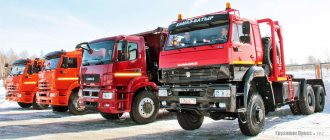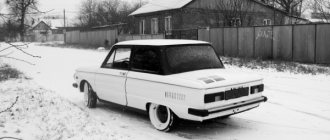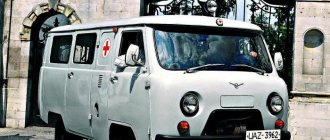Fire tanker ATs-10.0-150(65225)018-MI - designed to deliver personnel, fire-fighting equipment and equipment to the site of a fire, carry out fire-fighting operations in large populated areas and on the territory of industrial enterprises, and carry out emergency -rescue work.
Multifunctional firefighting tankers are a new generation of basic firefighting vehicles that combine the functions of several firefighting vehicles.
ATs-10.0-150(65225)018MI is a multifunctional heavy-duty fire-fighting tanker truck on a powerful all-wheel drive KAMAZ-65225 (6 × 6) base chassis, with the installation of a high-performance pump UNVP-150. A modern, ergonomic vehicle with an increased range of fire extinguishing agents, designed for use at critical facilities.
Fire truck ATs-10-150
History of creation
The next after the 537th series was the military modification of the MAZ-543. In it, only the frame and axles remained from the previous version, improved components were added, speed and dynamic performance were increased. Thanks to them, the car was named “Hurricane”, which reflected its power and all-terrain capability. The first models off the assembly line were sent to Volgograd, where they were used in testing rocket launchers.
In 1974, the prototype of the MAZ-7310 truck was released. An onboard platform appeared here, but additional equipment and the ability to operate as part of a road train were removed. Conveyor production was launched only 2 years later - in 1976.
MAZ 7310 tractors were used mainly for towing trailers and transporting goods. An all-metal cargo platform with high sides made it possible to transport large items - the height of the sides reached 2 m. There were also new, improved 14-ply tires and a reinforced rear suspension.
Two years before the car was launched into mass production, it was tested at 21 research institutes. The USSR-era military MAZ 7310 was used in the army in limited quantities, but found its main application in cargo transportation.
The MAZ 7310 tractor with fire extinguishing equipment on board is used to fight fire at airfields. It is equipped with a water storage tank with a total volume of 12 tons and a container with a foaming agent. “Pozharki” based on the brainchild of the Minsk Automobile Plant are actively used in the countries of the post-Soviet space today.
Characteristics of the basic version
The all-wheel drive truck of the MAZ 7310 modification is equipped with an onboard platform and belongs to the class of heavy wheeled tractors. Technical characteristics of MAZ 7310 (basic version):
- dimensions 11657/2975/2950 mm (length/width/height);
- front and rear track – 2375 mm;
- ground clearance - 400 mm;
- turning radius 13500 mm;
- total weight up to 43.3 tons, loaded - 23 tons, load capacity - up to 20 tons;
- when towing a trailer, its weight is up to 65 tons.
The engine for this tractor model was powerful diesel units of the D-12-525A series based on the V-2 engine, which was actively used in tank equipment. Jet fuel atomization and water cooling are implemented here. The “8 by 8” wheel arrangement when equipped with such an engine provides high traction even for such heavy vehicles and allows you to move heavy loads over long distances.
The engine displacement is 38.8 liters, rated power is 525 horsepower. The declared service life of the engine is 55 thousand km. Fuel consumption is one of those points that does not allow these cars to be actively used for civilian purposes - up to 125 l/h. The basic version has two fuel tanks with a capacity of 420 liters; the capacity can be increased to 1220 liters.
The gearbox determines how many speeds are in the MAZ 7310. Here it is three-speed, manually controlled, mechanical.
Specifications
The first missile carrier from the MAZ 543 line had a payload capacity of just over 19,000 kg. Over the course of history, more than one and a half thousand such copies have rolled off the assembly line. Some of them were sent to East Germany, where the chassis was used as a truck with a body to transport soldiers.
Towbars made it possible to turn the car into a full-fledged tractor. For example, some examples were converted into mobile housing, utility vehicles and other models.
The first missile system to be mounted on this chassis was the TEMP tactical complex. Later it was replaced by the 9P117 installation.
In addition, the MAZ 543 base housed:
- mobile communication stations;
- combat control posts;
- missile systems of various generations and purposes;
- military truck crane, etc.
Cabin
Connoisseurs must have wondered why this cabin layout was chosen. It's simple, the first TEMP missiles were more than 12 meters long, so it was necessary to place them somewhere.
At first they just wanted to make a small recess in the center of the cabin. But it was not possible to do this from the technical side. It seemed that the only solution was to use a longer frame. However, Shaposhnikov decided to take an unconventional route and divided the control post into two parts, between which the rocket could be placed.
Previously, this method had not been used in the design of military equipment, but it turned out to be the only correct solution. Also, when creating the cabin, engineers decided to use non-metal sheets. They preferred a reinforced polyester resin that resembles plastic.
At first, everyone was skeptical about this decision, but tests proved the reliability and strength of the material. For reinforcement, additional armored plates were used, which were hung from above. Each cabin had two seats.
Military MAZ
When developing the car, not only domestic parts produced in the USSR were used, but also innovative ideas from designers at that time:
- frame made of two load-bearing parts of a curved shape, created by welding and riveting;
- torsion bar suspension with levers, which ensures a smooth ride;
- hydromechanical four-speed gearbox with the ability to switch without loss of power;
- 8-wheel drive with automatic inflation function, supplemented by a pressure regulation system (to increase cross-country ability in any conditions);
- twelve-cylinder power plant from the D-12A-525 tank with a displacement of over 38 liters and a rated power of over 500 hp. With.;
- two tanks for diesel fuel with a volume of 250 liters (a third reserve tank of 180 liters);
- the weight of the car is on average 20 tons (depending on the modification and purpose);
- braking distance of at least 21 m.
dimensions
- length 11.26 m;
- height 2.9 m;
- width 3.05 m;
- ground clearance 40 cm;
- track 2.375 m;
- turning radius 13.5 m.
Fire extinguishing modifications
Airfield fire-fighting vehicles based on sample 7310 are distinguished by their high quality and performance, which is why they are still used today.
AA-60
A fire fighting vehicle based on the MAZ-543 chassis was created at KB-8 in Pryluky. Its distinctive feature can be considered a powerful pump, the productivity of which is 60 l/s. It entered serial production back in 1973 at the fire fighting equipment plant in the city of Priluki.
Characteristics of MAZ 7310 modification AA-60:
- Purpose. Used to suppress fire at airports directly in aircraft and buildings and structures. Due to its dimensions, such a vehicle is also used to deliver personnel, as well as equipment and special fire extinguishing equipment.
- Water can be supplied from open sources (reservoirs), water pipes or from a tank. It can also use air-mechanical foam using a foam concentrate from a third-party or its own container.
- Terms of Use. Can be used at extremely low or high temperatures in any climatic zones of the country.
- Main characteristics. Equipped with a foam concentrate with a volume of 900 liters and a carburetor engine with a capacity of 180 liters. With. The peculiarity of the pump is that it can operate at different speeds.
The car is adapted to work at any temperature. During the cold season, the main engine, pumps and tanks are heated by an electrical heating system, which is powered by a generator. If it fails, heating from the gasoline system is possible.
The monitor can be controlled manually or from the driver's cab. There are also 2 portable units that are used to extinguish fire in the cabin or cabin of an aircraft, as well as in enclosed spaces.
Modifications of AA-60
The main version of the AA-60 fire truck was improved several times and received three modifications:
- AA-60(543)-160. Airfield heavy fire fighting vehicle, created on the basis of the MAZ-543 chassis. It has technical characteristics similar to the basic version, the main differences are the increased volume of the water tank, the capacity of which is 11,000 liters. Produced in limited edition.
- AA-60(7310)-160.01. Fire trucks for use at airfields, created directly on the basis of the MAZ 7310. The water supply here is 12,000 liters, and an autonomous pump drive is also implemented. It was produced for 4 years - in 1978–82.
- AA-60(7313)-160.01A. Another modification of the airfield fire extinguishing vehicle, which has been produced since 1982.
In 1986, the MAZ-7310 was replaced by the successor MAZ-7313 - a 21-ton truck, as well as its modified version MAZ-73131 with a load of almost 23 tons. All of them were based on the same MAZ-543.
AA-70
This modification of the fire truck was also developed in the city of Priluki in 1981 on the basis of the MAZ-73101 chassis. This is an improved version of the AA-60, the main differences of which are:
- additional powder storage tank;
- reduced water supply;
- high performance pump.
The body accommodates 3 tanks - for powder with a volume of 2200 l, for foam concentrate 900 l, and for water 9500 l.
In addition to extinguishing objects at the airfield, the vehicle can be used to extinguish overpasses with oil products and tanks with a total height of up to 6 m.
The MAZ 7310 special equipment, which carries fire extinguishing equipment on board, is operated today at airfields for its intended purpose in many post-Soviet countries. Such vehicles are not only adapted to the harsh climatic conditions of the northern regions, but also meet all the needs of crews when fighting fire in aircraft and structures at airfields.
Super firefighter on the latest super chassis MAZ-63182M
This “monster” is called the airfield extinguishing vehicle AA 12.0-100 (6318). It was created jointly by Borisov and the Minsk Automobile Plant. The MAZ-63182M chassis with a 6x6 wheel arrangement was specially developed for the “airfield”.
Of course, this is not the first time that Pozhsnab has used MAZ all-wheel drive chassis for its fire trucks. By the way, a car similar in purpose is still produced on the well-known MAZ-6317 (6x6) chassis. But the new product is significantly superior in its characteristics to everything that came before. In addition, MAZ designers made a number of improvements that made the work of the combat crew easier.
The developers of the chassis for the new airfield extinguishing vehicle had to fit into fairly stringent requirements. One of the main ones is the minimum acceleration time to 80 km/h. To accomplish this, the chassis was equipped with a 550-horsepower 6-cylinder in-line Weichai WP13.550 engine - this is the most powerful engine used on modern production vehicles of the Minsk MAZ car, of course, it doesn’t count). With this “beast”, the new fire truck, whose total weight is 35,000 kg, is well within the standards: the travel time from zero to stop along a straight route 2000 m long with an asphalt or concrete surface is no more than 80 seconds. Maximum speed is 115 km/h.
The installation of an Allison 4500 automatic transmission on the MAZ-63182M chassis not only made it easier to drive the vehicle, but also ensured continuous power transmission to drive the fire equipment pump when creating a “foam cushion” (the PTO can be turned on while the vehicle is moving, without stopping it). Other features of the new product are a switchable front drive axle and a two-speed ZF transfer case.
The body superstructure is of a modular type, the compartments are made of aluminum alloy. The capacity of the water tank is 11,000 l, the capacity of the foam tank is 1400 l. Fire pump capacity - 100 l/s; fire monitor - 80 l/s; bumper installation - 30 l/s.
The foam concentrate supply and dosing system is automatic, providing proportional foam mixing in the range from 0.1% to 9.9% (in increments of 0.1), with the ability to store two preset values for quick selection. Water and foam communications are controlled remotely from two remote controls located in the driver’s cab and in the pump compartment.
In addition, there is a carbon dioxide extinguishing installation with a capacity of 120 liters. The kit includes two manually driven reels with a sleeve length of 30 m. One of the reels is equipped with a bell-barrel, the other with a punch-barrel.
There is a system for protecting the chassis and wheels from flames - it is made in the form of nozzles located around the perimeter of the car.
The cabin is metal-fiberglass, single-volume, 2-row, 4-door. Combat crew - 6 people. To facilitate access to the driver's workplace, the cab is lowered due to the modification of its suspension. The interior has become more modern and functional.
Sergey GRISCHENKO Autobusiness Photo LLC "Pozhsnab"

